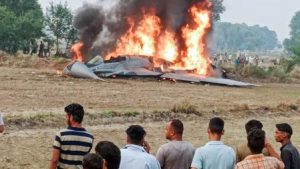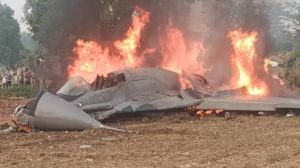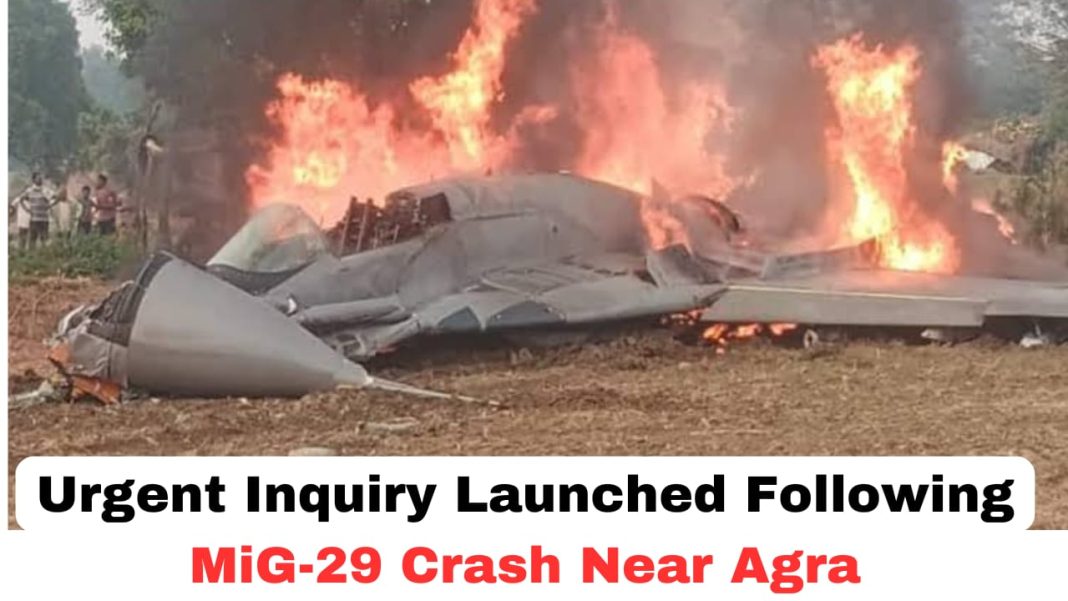Digital News Guru:
A MiG-29 fighter jet crash in Uttar Pradesh , has raised concerns about military aviation safety and the operational longevity of India’s aging fighter fleet. The crash occurred during a routine training exercise, with the pilot managing to eject safely, avoiding any loss of life or injury on the ground. This incident highlights several issues, including the strain on India’s fleet, potential maintenance challenges, and the need for modernization within the Indian Air Force (IAF).
Incident Overview and Pilot Response
During the training mission, the MiG-29, which was stationed at the Adampur Air Force Base in Punjab, was reportedly flying over rural areas in Uttar Pradesh near Agra when the pilot detected an issue that forced them to eject. The ejection seat system functioned as designed, allowing the pilot to escape without harm. The Indian Air Force has ordered an investigation to determine the cause of the crash, which remains unknown pending the initial findings.

The prompt and safe ejection illustrates the extensive training IAF pilots receive in handling in-flight emergencies. The IAF’s approach emphasizes preparedness, requiring pilots to undergo regular ejection drills and emergency response exercises. The quick reaction by the pilot prevented a potentially disastrous situation, particularly given the populated regions in Uttar Pradesh that the aircraft could have impacted.
Background of the MiG-29 in the Indian Air Force
The MiG-29 has been a critical asset for the IAF since its induction in the 1980s, originally procured to counterbalance advanced fighter capabilities in the region. Known for its high maneuverability, speed, and powerful engine, the MiG-29 has contributed to both air defense and offensive roles for decades. However, despite upgrades to the fleet under the MiG-29UPG modernization program, the aircraft is experiencing increasing incidents as maintenance challenges mount due to age and wear.
India is among a few countries still actively operating the MiG-29 in large numbers. Despite their legacy, the aircraft require constant maintenance and replacement of key parts. The older MiG models, in particular, are more prone to technical malfunctions, which has spurred debate over the risks involved in keeping older fighter jets in service.
Aircraft Safety and Maintenance Concerns
The crash underscores the ongoing challenges associated with maintaining an aging fleet. The IAF has prioritized upgrading certain aircraft, including the MiG-29, through structural enhancements, avionics upgrades, and the integration of advanced weaponry. However, some military experts argue that the MiG-29, despite these upgrades, may be reaching the end of its operational viability. With the IAF still using a variety of Soviet-era aircraft alongside newer models, maintenance is costly and challenging, often requiring international sourcing of parts and specialized engineering skills.

India’s commitment to balancing operational readiness with economic constraints is evident in its modernization program, but the pace of replacement has not been swift enough to address the risks posed by the older fleet. High-profile accidents, such as this MiG-29 crash, bring renewed focus to the pressing need for new-generation fighters in the IAF’s inventory. The Rafale acquisition from France and India’s own Tejas Light Combat Aircraft (LCA) program represent positive steps, though they may not yet replace all the roles performed by aging models like the MiG-29.
Implications for Modernization and Strategic Goals
India’s Air Force modernization has become a critical component of the nation’s broader defense strategy, particularly with its focus on securing regional air superiority. The country’s procurement of advanced platforms such as the Rafale, along with joint ventures for next-generation aircraft development, demonstrate its commitment to long-term strategic improvements. Yet, transitioning fully to a modern fleet remains a significant challenge, as existing MiG variants, including MiG-21s and MiG-29s, continue to account for a sizable portion of the fleet.
The MiG-29 crash adds to a recent history of accidents that have intensified public and political discourse on IAF modernization. Many experts advocate for an accelerated timeline to retire older aircraft and replace them with modern alternatives, as well as stronger investment in indigenous production capacities. The development of the Advanced Medium Combat Aircraft (AMCA) by India’s Aeronautical Development Agency and Hindustan Aeronautics Limited is expected to serve as a long-term replacement for these older fighters. However, until these new platforms are fully operational, the IAF remains reliant on its legacy fighters, necessitating increased investments in safety measures and maintenance protocols.

Response from the Government and Future Prospects
The Indian government has expressed continued support for the IAF’s modernization efforts, with recent defense budgets reflecting increases in funds allocated to aircraft procurement and indigenous defense manufacturing. The “Make in India” initiative plays a central role in this strategy, as India seeks to build a self-reliant defense sector capable of supplying advanced fighter jets and reducing dependency on foreign imports.
Following the crash, government officials and defense analysts have called for an expedited review of maintenance practices and operational protocols for legacy fighters. The Ministry of Defense is expected to monitor the findings of the IAF’s investigation into this incident closely, with the possibility of implementing new maintenance schedules or operational guidelines.
Conclusion
The MiG-29 crash near Agra serves as a stark reminder of the challenges India faces in maintaining its aging fleet while modernizing its air defense capabilities. As the IAF works to balance the operational demands of an aging fleet with the imperative for modernization, incidents like this underscore the importance of ensuring pilot safety and minimizing the risks associated with legacy aircraft. The pilot’s safe ejection and quick response prevented a more serious outcome, underscoring the IAF’s training and preparedness standards.
Looking forward, the incident reinforces the need for India to accelerate its defense modernization agenda, both through acquisitions of advanced fighter jets and through support for indigenous projects like the Tejas and AMCA programs. Balancing these needs against budgetary constraints and strategic goals will be critical for India as it seeks to maintain regional air superiority and enhance the safety and efficacy of its Air Force operations.
You May Also Read: What to Look for When Buying a Second-Hand Car: A Step-by-Step Approach








